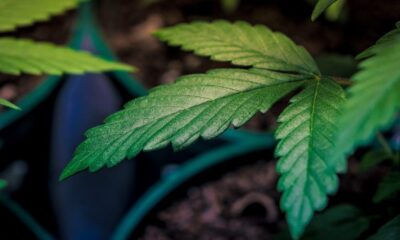featured
The Evolution of Cannabis in Film
Published
2 days agoon
This article was originally published in the September 2020 issue of High Times Magazine. Subscribe here!
Contemporary Storytelling
The arrival of film caused the world to change in drastic ways. It created a whole new way to tell stories, giving birth to a new type of fame and talent that has turned into one of the most popular ways to consume entertainment to this day. Film connected people to famous stories of the future with Metropolis, introduced horrific tales in Frankenstein and King Kong, and created fantasy in ground-breaking animation in Disney’s Snow White and the Seven Dwarves. Film is the reason that man was able to witness astronauts walking on the moon (or a fake recording, if you’re one of those people). Human history is saved in vibrant technicolor, black and white, and 4,000K, thanks to the advances of technology.
There have been so many unique advances in film that we would be remiss without focusing on the topic that is nearest and dearest to our hearts—marijuana. Just as the industry has evolved from its underground, black market roots, so too is that transition documented in the various films that focus on or mention Mary Jane. Here is the evolution of cannabis in film.
The Devil’s Lettuce
The history of film is rich in facts. The earliest motion pictures first made their appearance around the conclusion of the 19th century. These films varied in length and experimentation, and the art of the silent film officially ended in 1927, when the first film to add sound received the title of “talkie.” Adding music and later, dialogue, to these films took the world by storm. It was only about one decade later that weed made its not-so-sparkling debut in the infamous film, Reefer Madness in 1936. “Drug-crazed abandon” and “Women cry for it—men die for it!” lined the film’s release posters—and the film became the poster child for over 70 years of stoner stereotypes. Featuring illegal underground market sales, underage consumption (and negatively impacted youth), rape, and murder, Reefer Madness created a fictional story that viewers saw as fact.
It isn’t a secret that cannabis was once used in some early 20th century medicines, but by the time the 1930s hit, the plant was prohibited by over 30 states. By 1937, the United States began its prohibition on cannabis with the Marihuana Tax Act of 1937. With that regulation, which was written by well-known prohibitionist Harry Anslinger, all cannabis (including hemp) became illegal to possess and sell. Reefer Madness set the foundation of expectation for cannabis as a negative act, specifically when it comes to fostering fear in those who had never tried it, and demonizing those who had.
Nearly 20 years later, High School Confidential hits theaters. In 1958, the stoner stereotypes were as strong as ever. The film revolves around an undercover cop who infiltrates high school students to uncover the presence of narcotics. Films that include narcotics usually emphasized as heroin, cocaine, or other harmful Schedule I substances—but in High School Confidential, the main focus is on marijuana. This view of marijuana as a drug is naïve in and of itself, but it successfully perpetuates negative connotations that come with consumption.
It’s a Lifestyle, Man
In 1969, the view of marijuana and the portrayal of drugs matured. Easy Rider is one of the first films to portray a bevy of drug use, which includes but is not limited to cocaine and LSD, and alcohol abuse as well. It follows the story of two motorcyclists delivering cocaine across the border and enjoying the various substances at their disposal. Having been released in the midst of the Vietnam War (which didn’t conclude until 1975) and at the end of the “free love” decade of hippies and rise of cannabis advocates, Easy Rider still perpetuated the idea that only bad people do drugs, as well as highlighted the negative consequences of those actions.
Things begin to change once the 1970s hit. Cannabis became paired with satire and parody in film for the first time with the animated adult film, Fritz the Cat (and coincidentally received the first X rating by the Motion Picture Association of America). It featured Fritz, whose journey mimics the freethinking radical college students of the 1960s. Its mature content included profanity and sex, but most importantly, marijuana use. It was a trailblazer in its time, not just because it satirized the stereotypes of cannabis consumption, but it built the foundation for adult animated entertainment that we see today in the form of shows like The Simpsons, South Park, and Family Guy.
The year 1978 may begin to ring a bell for longtime readers. With the foundation of Fritz the Cat blazing the trail for comedy, up comes along Richard Anthony “Cheech” Marin and Tommy Chong with their debut film, Cheech and Chong: Up In Smoke. The duo made history introducing its characters as banner men of the counterculture that was developing, having worked together for somewhere around 10 years before a movie was released. While it also preserved the stoner stigma (if not strengthening it), Cheech and Chong: Up In Smoke played out the adventure of the stoner buddies beautifully. It gave stoners an anthem to support recreational cannabis use, not to mention an identity they could finally get behind as a culture.
Cheech & Chong’s Up in Smoke and Cheech & Chong’s Next Movie, released in 1980 and 1981 respectively, helped the comedy counterculture identity thrive. Once the 1980s hit, and success was found in the stoner film, other films went into production as well. It was suddenly very popular to portray marijuana consumption as comedic antics.
Fast Times at Ridgemont High followed closely after Cheech & Chong’s third film, released in 1982. It’s a typical coming-of-age tale of students in high school, one of which is described as both a stoner and a surfer (played by Sean Penn). The stereotypical “stoner” persona really took form in this movie, as well as many others that released in the ’80s. Usually male and still in their youth, the stoner has been notoriously categorized as lazy or a distraction to others—however, this never stops them from having fun and enjoying life in a stress-free and relaxed manner. By 1989, the stoner characters were well established, and were even represented in films without any direct cannabis references. Bill & Ted’s Excellent Adventure plays off this approach to the stoner archetype. Dazed and Confused (1993) follows the same coming-of-age recipe as Fast Times at Ridgemont High.
Broadening the Stereotype
Then in the mid-1990s, the most famous stoner films began to exhibit some diversity. With Friday (1995) and Half-Baked (1998), these films shifted the now-predictable narrative of the life of a stoner, which was typically presented only as white males. Friday featured famous Black actors and showed various types of cannabis consuming personalities. For example, Craig Jones, played by Ice Cube, was an intelligent, serious, relaxed, and yet jobless consumer, while his cousin Smoky, played by Chris Tucker, was a high-energy consumer who was holding down a real job. Later, stoner comedy How High (2001) continued to add Black representation with Method Man and Redman as the lead actors. Then the world was introduced to some Indian and Asian representation of weed humor in Harold and Kumar Go to White Castle (2004). This is a small but monumental shift in the stoner meta, which has continued to evolve.
In 2007, one of the first stoner films to feature a female star (as played by Anna Faris) was seen in Smiley Face. This was just the beginning. Portraying marijuana consumers as anybody, rather than just white males, became a major statement in convincing skeptical non-consumers that medical and recreational cannabis is for everyone.
But in the 2000s and onward, diversity in stoner comedies was still followed by movies whose main characters fit the traditional stoner that goes back decades in film. Dude, Where’s My Car? (2000), Clerk’s II (2006), Grandma’s Boy (2006) all portrayed an evolving version of the white stoner characters and adventures. In 2007, the film Knocked Up displayed the stereotyped stoner of a man who gets a woman pregnant, but in the end he realizes that having a family means ditching his “bad” habits (marijuana use, among other daily things). Stoner films were beginning to recognize their characters as real people making real decisions, rather than pure stoners having fun on adventures with few consequences. Again, it must be reiterated that the evolution of stoner films has changed at this point, but there is and always will be new renditions of stoner film adventure.
The Tipping Point
Things began to change drastically following the states that began to legalize recreational cannabis. The first of these are apparent in Colorado and Washington in 2012, followed by Alaska and Oregon in 2014, and so forth. Cannabis was becoming a national topic in the US, and people’s opinion of the herb was changing at a rapid pace. Cannabis in film took a sharp turn, from the stoner film hero to real life heroes instead. One of the first notable cannabis documentaries, entitled Weed, came out in 2013. Featuring CNN’s Chief Medical Correspondent Sanjay Gupta, this documentary validated cannabis as medicine, as seen through the life of young Charlotte Figi who was experiencing near-miraculous improvements in her daily seizures by taking medical cannabis oil. Advocates had been crying out for easier access to medical cannabis for the sake of children and adults alike, but it took the recognition of a national health officer to spread the word—ditching the stereotypes completely and recognizing cannabis for its merits, which Gupta witnessed firsthand.
Cannabis has blossomed into being worthy of film festivals in recent years as well. Like all film festivals, it features the unique talents and vision of filmmakers that share cannabis as a common ground. This resulted in a number of short films and full-length films that explored what cannabis is and what it means to smoke cannabis and experience its unique effects. A cannabis film festival was featured in California for a few years. The SPLIFF Film Fest is still happening this year—stuck at home style! The New York City Cannabis Film Festival was active for many years, while the Colorado International Cannabis & Hemp Film Festival has been operating for four years, and the show continues.
Stoner Comedies Live On
In the last decade, comedy stoner films are still easily recognized and will never cease being made, but the plots at least have been changed. Using a fill-in-the-blank description, comedic stoner films have turned into “What if we make a stoner film but…” Your Highness (2011) fits the bill perfectly, featuring a stoner comedy that takes place in a medieval setting. Want a stoner film with zombies? Enter Bong of the Dead (2011). How about a stoner film where the main character’s teddy bear comes to life, and—wait for it—is also a stoner. We’re looking at you, Ted (2012).
Reboot films have also been very prevalent within the past two decades or so, and some of the most iconic stoner films aren’t exempt from that. Jay and Silent Bob Reboot (2019) hilariously approaches the idea of characters Jay and Silent Bob losing the rights to their own characters. Just last month, Bill & Ted Face the Music released, completing a Bill & Ted film trilogy.
Beyond the Funny
While the use of cannabis still shows up in a lot of comedies, more recently we’ve seen marijuana films branch out into other genres. Star Leaf (2015) brought us a cannabis-centric horror/sci-fi/thriller movie. The plot involves a war veteran who finds extraterrestrial marijuana that can treat his PTSD. Another shining example of a cannabis film that doesn’t need comedy is The Marijuana Conspiracy (2020), which is categorized as a drama that is based on a true story. Based in 1972, this movie tells the story of women who were isolated for almost 100 days as part of an experiment studying the effects of marijuana.
More recently, we’ve also seen an increase in the variety of documentaries that broaden the stereotype of who the real-life cannabis consumer is. Rolling Papers (2015) is a documentary that delves into the world of pot journalism as it became mainstream with The Cannabist Editor Ricardo Baca as the main character.
Other non-typical consumers who served as main characters in recent documentaries include the nuns in Breaking Habits (2018). Additionally, Weed the People (2018) shares stories about young children who find miraculous healing through medical cannabis. Another film, A Life of Its Own: The Truth About Medical Marijuana (2017), focused on the compelling science and cutting-edge research behind the plant’s medicinal properties. It’s clear that nonfiction education on the plant through film has helped round out the portrayal of cannabis in society.
Cannabis Cinema is Here to Stay
We’ve come a long way from the hysteric propaganda stoner movies that were born from the days of early film. Films today include cannabis consumers from all walks of life. What can we expect from the next generation of pot in film? Will cinema eventually evolve to portray cannabis consumers in even more favorable and positive ways? All we know is that once movie theaters reopen, we’ll be the first in line for any type of movie that involves weed. Until then, we’re ready to stream whatever is on the queue.

Author: mscannabiz.com
MScannaBIZ for all you Mississippi Cannabis News and Information.
You may like
-


Marijuana Users In Iowa Are Engaged And Active Citizens, Survey Shows—Smashing ‘Lazy Stoner’ Stereotypes
-


Here’s Where To Buy Legal Recreational Marijuana In Delaware Next Month
-


Fireworks, marijuana and cash found in Bronx apartment – NBC New York
-


How often are marijuana cases federally prosecuted?
-


A Brief History of Getting High
-


Rhode Island Marijuana Regulators Seeking Applications For New Dispensary In State’s Northern Region
featured
Marijuana Users In Iowa Are Engaged And Active Citizens, Survey Shows—Smashing ‘Lazy Stoner’ Stereotypes
Published
2 hours agoon
July 6, 2025
“Many of today’s cannabis consumers are ‘middle American’ adults, employed, own a home, vote regularly, pay their taxes and are involved in their communities.”
By Bob Sillick, Iowa Capital Dispatch
For many years, cannabis users were characterized as a cult of stoners: young, often unemployed, party animals. That sector still exists in some form, however, many of today’s cannabis consumers are “middle American” adults, employed, own a home, vote regularly, pay their taxes and are involved in their communities.
That is the general profile of adult cannabis consumers across the country and in Des Moines, according to a recent survey by Consumer Research Around Cannabis/The Media Audit.
The Media Audit, the parent company of Consumer Research Around Cannabis, is an international research company serving 80+ local markets in the U.S. and Canada for more than 20 years. It started gathering data about cannabis use and attitudes in 2016.
Although the sale of adult recreational cannabis is illegal in Iowa, the survey found 16.2 percent of all adults age 18+ in Des Moines said they used or bought cannabis during the past month, or the statistical equivalent of approximately 140,000 adults.
The smallest percentage in the following table, monthly usage in Des Moines, is still substantial—and suggests a pent-up market. Unleashing the recreational cannabis market in Des Moines and all of Iowa would likely generate jobs and significant taxes for the state—money now escaping across the borders.

The survey data from Des Moines and 42 other markets was aggregated and showed 24.1 percent of adults 18+ used or bought cannabis during the past month. (Local factors affect these percentages and comparisons.)
For 15 years, Jonathan Caulkins, H. Guyford Stever professor of operations research and public policy at Carnegie Mellon University’s Heinz College, has been studying cannabis legalization. He is also the author of several books on the topic and a member of the Commission on the North American Opioid Crisis.
Caulkins’s research fine-tunes the results of the Des Moines survey from Consumer Research Around Cannabis.
“From 1992 through 2023, the most recent year for which we have released data, the trend has been towards an enormous increase in the number of people who are using cannabis daily or near daily. They account for 80 percent of recreational cannabis sales. They dominate the market,” Caulkins said.
In states like Iowa that haven’t legalized adult recreational cannabis, Caulkins expects when they do, the middle of the market will be blue-collar high-school graduates, adults 25–40 who are employed but not affluent.
He has also seen a gender trend as more states allow the sale of recreational cannabis.
“As cannabis has become more legal, the male/female use gap has become noticeably smaller. When it was an illegal action or a risky action, there was a much bigger gender gap, but that gap is declining. Use by men is increasing with legalization, use by women is increasing even more,” he said.
Cannabis consumers in Des Moines also align with the 43-market survey when comparing gender and income. Millennials at 42.3 percent and Gen Xers at 35.5 percent account for three-quarters of the adult cannabis consumers in Des Moines who bought or used cannabis during the past month. These percentages are slightly more than the 43-market survey at 41.5 percent and 28.2 percent, respectively. The 33.8 percent of cannabis consumers in Des Moines with household incomes of $35,000 to $75,000 is also slightly more than the 43-market survey at 29.6 percent.
The Consumer Research Around Cannabis data also profiles cannabis consumers at a more granular level. The “household profile” category shows which three were the largest purchasers or users of cannabis during the past year, or 33.8 percent collectively.
- Affluent, no children at home: $75,000+ household income
- Affluent white-collar worker: Family income $100,000+
- Affluent Boomers: $100,000+ household income
Comparing cannabis purchasers and users in Des Moines with the 43-market survey by their employment status and occupation reveals some contrasts. The data indicates that many in Des Moines are working and contributing to the local economy.

Voting is a meaningful measure of civic responsibility. Millennials at 22 percent, Gen Xers at 54.4 percent and Baby Boomers at 12 percent who purchased or used cannabis during the past month voted in local, state and national elections, compared to 33 percent, 32.1 percent and 24.6 percent, respectively, in the 43-market aggregate survey.
This particular data point may have ramifications for future legislative efforts to legalize adult recreational cannabis sales in Iowa. While the Iowa Legislature’s majority Republicans have rebuffed Democrats’ proposals to legalize recreational marijuana, advocates suggest time may be on their side if an increasing body of citizens support legalization with their votes.
Marijuana’s Schedule I Status ‘Traps Researchers In A Paradox,’ Federally Funded Scientists Say

Author: mscannabiz.com
MScannaBIZ for all you Mississippi Cannabis News and Information.
featured
Here’s Where To Buy Legal Recreational Marijuana In Delaware Next Month
Published
3 hours agoon
July 6, 2025
All seven medical marijuana operators have converted to adult-use cannabis sales, with over 10 locations, which will be up and running in August.
By Brianna Hill, Spotlight Delaware
Delaware will begin recreational marijuana sales on August 1, state officials announced Tuesday, putting the first definitive date on the start of a long-awaited rollout for the $280 million industry.
Customers on that first day will be heading to existing medical marijuana businesses though, as the burgeoning legal market has yet to develop the dozens of new businesses licensed for recreational-only sales.
That decision has already sparked criticism from advocates and residents, who say it puts other businesses at an unfair disadvantage.
For years, medical marijuana dispensaries have denied that they sought the handful of licenses available at the time in order to get a first-adopter advantage for the eventual recreational market. But now that is occurring.
“The existing medical marijuana dispensaries lobbied for less competition and to begin sales before new businesses, and now, with the [Office of the Marijuana Commissioner]-caused delays, they will end up with first sales and absolutely no competition,” Zoë Patchell, president of the Delaware Cannabis Advocacy Network, which advocated for years for legalization, wrote in a Facebook post.
Delaware medical marijuana dispensaries

Jacob Owens, Spotlight Delaware / Source: Delaware Office of the Marijuana Commissioner / Created with Datawrapper
- First State Compassion–Wilmington, 37 Germay Drive, Wilmington http://firststatecompassion.com
- First State Compassion–Lewes, 12000 Old Vine Blvd., Unit 102, Lewes
- http://firststatecompassion.com
- Fresh Cannabis, 635 N. Dupont Blvd., Milford
- https://freshdelaware.com/
- Columbia Care Delaware, 200 S. DuPont Blvd., Smyrna
- https://col-carede.com/
- Columbia Care Delaware, 5606 Concord Pike, Wilmington
- https://col-carede.com/
- Columbia Care Delaware, 36725 Bayside Outlet Drive, Suite 760, Rehoboth Beach
- https://col-carede.com/
- Field Supply, 4543 Kirkwood Highway, Wilmington
- https://thefieldsupply.com
- Fresh Cannabis, 800 Ogletown Road, Newark
- https://freshdelaware.com/
- Fresh Cannabis, 22983 Sussex Highway, Seaford
- https://freshdelaware.com/
- The Farm, 105 Irish Hill Road, Felton
- https://www.thefarmde.com
- The Farm, 240 S. Dupont Highway, New Castle
- https://www.thefarmde.com
- Best Buds, 516 Jefferic Blvd., Dover
- https://www.bestbuds.com
- Best Buds, 23 Georgetown Plaza, Georgetown
- https://bestbuds.com
Delaware’s adult-use marijuana industry, which was legalized in 2023, allowed for 125 licensees to operate throughout the state across cultivation, manufacturing, testing and retail sales. The operators were chosen at the end of last year through a lottery system that saw more than 1,200 individuals apply.
Entering the licensing lottery alone required individuals to submit detailed applications and fees. Most application fees cost $5,000, with the active license itself costing up to $10,000.
Medical marijuana operators seeking to enter the recreational market were required to pay steep conversion fees—$100,000 for retail or manufacturing licenses and $200,000 for cultivation.
The state used the revenue to create a $4 million reimbursement fund for social equity applicants, defined as individuals with prior marijuana-related convictions or those from communities disproportionately impacted by prior marijuana enforcement.
Since March, business operators have been awaiting clarity from the Office of the Marijuana Commissioner (OMC), the state office in charge of regulating the industry, on when sales could legally begin.
The market’s launch was originally slated for April but faced delays after the state failed to secure FBI approval to conduct background checks on licensees.
As of June 18, 43 individuals have cleared their background checks, according to OMC spokeswoman Keila Montalvo. The office did not respond to requests for information on how many conditional licenses have been issued.
Even as an official date is set, state lawmakers are still trying to revise the law that made recreational sales legal.
The law permitted municipalities to prohibit marijuana businesses from their jurisdictions and gave counties broad authority to dictate where they could locate, but those allowances have led a third of Delaware towns and cities to opt out of allowing marijuana shops and Sussex County to place significant restrictions on locations.
A bill to lessen those restrictions has passed both the House and Senate and now awaits consideration from Gov. Matt Meyer (D).
All seven medical marijuana operators have converted to adult-use cannabis sales, with over 10 locations, which will be up and running in August.
Given the ongoing barriers faced by other licensees, including strict local zoning rules, delayed funding for social equity applicants and pending conditional license approvals, the early start for medical marijuana businesses could give them a major head start in shaping the market.
“Our focus is on building a safe, equitable, and accountable marijuana market that delivers real benefits to Delawareans. We will continue to issue conditional licenses to previously selected applicants to ensure they can begin operations once active,” Joshua Sanderlin, Delaware’s new marijuana commissioner, said in a statement.
This story was first published by Spotlight Delaware.
8 In 10 Marijuana Consumers Use It As A Substitute For Prescription Drugs, New Survey Finds

Author: mscannabiz.com
MScannaBIZ for all you Mississippi Cannabis News and Information.
Nowadays, people tend to associate the cannabis plant with Mexico, and for good reason. For decades, narcos smuggled their harvests into the United States and Europe. Along with California, Mexico is known to produce some of the finest cannabis in the world. The states of Sinaloa, Nayarit, Jalisco, Michoacán, Guerrero, Oaxaca, Chihuahua, Sonora, and Durango—where the largest farms are located—all have climates that are perfect for cultivating cannabis: year-round temperature ranging between 70 and 85 degrees Fahrenheit, with cool, long nights and low humidity.
But long before cannabis was introduced to—and became synonymous with—the New World, it was being cultivated in the lands of Central Asia. Initially, though, the cannabis or hemp plant was grown not for its leaves but for its stems, which could be processed into a strong and durable rope.
Excavations reveal that humans have been using hemp rope since the Neolithic age. The earliest evidence for burning cannabis, meanwhile, dates back to 3,500 BC, and is attributed to the Kurgans of modern-day Romania. This Proto-Indo-European tribe probably burned the plant as part of their rituals and ceremonies, a practice that spread eastward as its practitioners migrated. Why the Kurgans burned cannabis is difficult to say. They may well have discovered the plant’s psychoactive properties by accident, only to find that the smoke heightened their connection with all things spiritual.
The earliest evidence for smoking cannabis comes from the Pamir Mountains in western China. There, in 2500-year-old tombs, researchers discovered THC residue inside the burners of charred pipes that were probably used for funerary rites. (Similar pipes, dated to the 12th century BC, were later found in Ethiopia, left there by a separate culture). These devices, compared to pyres, would have yielded a much stronger high. Given their placement inside a crypt, however, it’s safe to say they were used only ceremonially, not recreationally.
Some scholars have argued that cannabis was an important ingredient of soma, a ritual drink concocted by the Vedic Indo-Aryans of northern India. Described in the Rigveda, a collection of ancient Sanskrit hymns, soma was made by extracting juice from an unknown plant. When taken in small doses, soma was reported to induce a feeling of euphoria. In higher doses, it caused people to see hallucinations and lose their sense of time. All three of these effects have been ascribed to cannabis, but even if cannabis was not the main ingredient of soma, it may have been combined with psychedelics such as psilocybin, a.k.a. magic mushrooms.
Aside from rope, cannabis was most often processed into medicine. When the Hindus of India came down with a case of “hot breath of the gods,” healers treated the illness with cannabis smoke. The logic behind this treatment was not exactly scientific; cannabis was thought to possess healing powers because it was the favorite food of the supreme godhead Shiva, also called “Lord of Bhang.” In reality, cannabis would have been able to reduce fevers because its active ingredient, THC, works on the hypothalamus to lower body temperature.
The Assyrians used cannabis not in a medical but in a religious context, burning it in their temples to release an aroma that supposedly appeased their gods. Sources from the region refer to cannabis as qunubu, providing a possible origin for the word we use today. The Assyrian Empire was conceived in the 21st century BC and lasted until the 7th. During this time, it engulfed much of modern-day Iraq as well as parts of Iran, Kuwait, Syria and Turkey. Through trade and conquest, Assyrian traditions spread to neighboring societies, including the Dacians, Thracians and Scythians, the latter of which were among the first to consume cannabis in a distinctly recreational manner.
The Scythians were part of a Central Asian nomadic culture that flourished from 900 to around 200 BC. Originating in northern Siberia, Scythian tribes settled as far as the shores of the Black Sea, where they came into contact with the ancient Greeks. When Scythians died, their friends and family burned hemp inside tents to commemorate their passing. While the Kurgans and Assyrians burned their cannabis out in the open or in large indoor spaces, the Scythians were essentially hotboxing themselves at every funeral. At least, that’s the image we receive from the historian Herodotus, who wrote that “the Scythians enjoy [the hemp smoke] so much that they would howl with pleasure.” And so, the primary purpose of this ritual was to send off the dead; it clearly also served to entertain the living.
Herodotus did not live among the Scythians, but his observations seem to have been confirmed by excavations. Archeologists discovered fossilized hemp seeds at a Scythian camp in western Mongolia that were left there between the 5th and 2nd century BC.
Romans, too, consumed cannabis for their own pleasure, but not in the way you might expect. Like many societies of classical antiquity, they harvested the plant for its seeds rather than its leaves, which were discarded as a waste product. When grounded, the seeds were used in medicine. When fried, they were served up as delicacies during lavish dinner parties. Roman chefs mentioned cannabis seeds in the same breath as caviar and cakes. Galen, the famous Roman physician, wrote that they were consumed “to stimulate an appetite for drinking.” Nowadays, it’s the seeds—not the leaves—that are considered useless. However, the Romans believed they, too, had some intoxicating properties; Galen adds that, when consumed in large amounts, the seeds would send people into a “warm and toxic vapor.”
Cannabis was so widely consumed in classical antiquity that people raised the same questions and concerns we are debating today. The Greek physician Pedanius Dioscorides, for instance, wrote that the plant’s spherical seeds, “when eaten in excess, diminish sexual potency.” Modern-day cannabis users are all too aware of the connection, even if they don’t eat seeds. As stated by Healthline, cannabis is “often associated with side effects that may affect sexual health, including erectile dysfunction.” Similar to some psychedelics, the general sense of euphoria generated by cannabis may counteract or override the reception of sexual stimuli.
Let’s skip forward a bit. Recreational smoking became especially popular after the 9th century AD. In the Middle East and Western Asia, the followers of Islam took up the habit for the simple but somewhat amusing reason that their holy scripture, the Quran, forbade the consumption of alcohol and various other intoxicating substances. Fortunately for Muslim stoners, the Quran did not say anything about weed. Of course, they smoked not just any weed, but hashish.
Skipping forward again, this time to the 16th century—the century that cannabis arrived in the New World, and for the sole purpose of making rope, no less. Actually, Americans did not start smoking weed until about one hundred years ago, when Mexican immigrants entered the country to seek refuge from the Mexican Revolution. For decades, the U.S. government turned a blind eye on this harmless, multicultural and age-old practice. However, this changed during the Great Depression, when Washington redirected the anger of unemployed workers to their Mexican brethren. After millennia of peaceful consumption, cannabis was suddenly decried as an “evil weed,” and, in 1937, the U.S. became the first country in the world to criminalize cannabis on a national level.
The rest, at this point in time, has now become history as well.
Original publication: 2022

Author: mscannabiz.com
MScannaBIZ for all you Mississippi Cannabis News and Information.

Marijuana Users In Iowa Are Engaged And Active Citizens, Survey Shows—Smashing ‘Lazy Stoner’ Stereotypes

Here’s Where To Buy Legal Recreational Marijuana In Delaware Next Month

Fireworks, marijuana and cash found in Bronx apartment – NBC New York

How often are marijuana cases federally prosecuted?
A Brief History of Getting High

Rhode Island Marijuana Regulators Seeking Applications For New Dispensary In State’s Northern Region

Texas Medical Marijuana Industry Wants Lawmakers To Ban Synthetic Delta-8 THC And Restrict Hemp Products To Adults

California Cannabis Operators Warn That New Tax Hike ‘Could Kill This Industry’
High Times Greats: Jim Morrison

New cannabis tax increase is a high concern for California dispensaries, customers
A Brief History of High Times (2019)

Georgia veterans suffering from PTSD push for medical cannabis expansion on Fourth of July
A Brief Global History of the War on Cannabis
The Evolution of Cannabis in Film
High Times Is Home Again
Dope As Yola Becomes First Weedtuber to Hit 2 Million Subscribers

$20M worth of cocaine, marijuana seized in Caribbean Sea: USCG
Will Success Spoil Cheech & Chong? Of Course (1980)
Prescription-Only Rule Takes Hold Amid Political Ouster

Marijuana Use Is Tied To ‘Significantly Higher Sexual Desire And Arousal,’ New Study Shows
Flashback Friday: Psychedelic Cacti

Trump’s VA Secretary Is ‘Particularly Proud’ Of Psychedelic Research Aimed At Helping Veterans With PTSD

Democratic Senate Sponsor Of Marijuana Banking Bill Says Budget Issues And War Have Delayed Cannabis Reform Efforts

Tifton Police: About 20 pounds of marijuana discovered during traffic stop

Alert: Department of Cannabis Control updates data dashboards with full data for 2023

Connecticut Appoints The US’s First Cannabis Ombudsperson – Yes there is a pun in there and I’m Sure Erin Kirk Is Going To Hear It More Than Once!

5 best CBD creams of 2024 by Leafly

Free delta-9 gummies from Bay Smokes

EU initiative begins bid to open access to psychedelic therapies
New Study Analyzes the Effects of THCV, CBD on Weight Loss

Mississippi city official pleads guilty to selling fake CBD products

May 2024 Leafly HighLight: Pink Runtz strain

Curaleaf Start Process Of Getting Their Claws Into The UK’s National Health System – With Former MP (Resigned Today 30/5/24) As The Front Man

5 best autoflower seed banks of 2024 by Leafly

Horn Lake denies cannabis dispensary request to allow sale of drug paraphernalia and Sunday sales | News

Press Release: CANNRA Calls for Farm Bill to Clarify Existing State Authority to Regulate Hemp Products

Local medical cannabis dispensary reacts to MSDH pulling Rapid Analytics License – WLBT

Discover New York’s dankest cannabis brands [September 2024]

Nevada CCB to Accept Applications for Cannabis Establishments in White Pine County – “Only one cultivation and one production license will be awarded in White Pine County”

6 best CBD gummies of 2024 by Leafly

The Daily Hit: October 2, 2024

5 best THC drinks of 2024 by Leafly

5 best delta-9 THC gummies of 2024 by Leafly

Weekly Update: Monday, May 13, 2024 including, New Guide for Renewals & May Board meeting application deadline

People In This State Googled ‘Medical Marijuana’ The Most, Study Shows

Thailand: Pro-cannabis advocates rally ahead of the government’s plan to recriminalize the plant

PRESS RELEASE : Justice Department Submits Proposed Regulation to Reschedule Marijuana

Press Release: May 9, STIIIZY and Healing Urban Barrios hosted an Expungement Clinic & Second Chance Resource Fair
Trending
-

 California Cannabis Updates1 year ago
California Cannabis Updates1 year agoAlert: Department of Cannabis Control updates data dashboards with full data for 2023
-

 Breaking News1 year ago
Breaking News1 year agoConnecticut Appoints The US’s First Cannabis Ombudsperson – Yes there is a pun in there and I’m Sure Erin Kirk Is Going To Hear It More Than Once!
-

 best list11 months ago
best list11 months ago5 best CBD creams of 2024 by Leafly
-

 Bay Smokes1 year ago
Bay Smokes1 year agoFree delta-9 gummies from Bay Smokes
-

 Business10 months ago
Business10 months agoEU initiative begins bid to open access to psychedelic therapies
-

 cbd1 year ago
cbd1 year agoNew Study Analyzes the Effects of THCV, CBD on Weight Loss
-

 Mississippi Cannabis News1 year ago
Mississippi Cannabis News1 year agoMississippi city official pleads guilty to selling fake CBD products
-

 California1 year ago
California1 year agoMay 2024 Leafly HighLight: Pink Runtz strain

